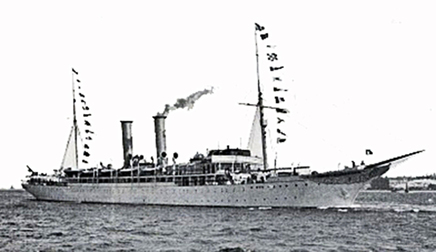What was the first cruise ship?
|
Prinzessin Victoria Luise is often regarded as the first cruise ship.
|
Ships have been carrying passengers throughout history. Indeed, they have been doing so at least since Noah's Ark. However, cruising is a relatively recent concept and ships built for the purpose of cruising are an even more recent invention.
In the 19th century, the North Atlantic shipping companies began to deploy ships that usually transported passengers between Europe and America on recreational cruises. For example, in 1895, Holland America Line's Rotterdam (II) did that line's first cruise - - a voyage from Rotterdam to Copenhagen and back. Other shipping lines offered similar voyages, especially in the winter months when demand for North Atlantic crossings declined. Still, the ships used for these cruises are more properly described as ocean liners rather than cruise ships (see separate article explaining the distinction). They were not built for the purpose of cruising but rather to transport people from one place to another much like airplanes do today. They only cruised occasionally. Their primary role was as a means of transportation, not recreation. The first ship purposely built for cruising was the Prinzessin Victoria Luise. She was the brain-child of Albert Ballin, the director of Germany's HAPAG (Hamburg-Amerikanische-Packetfahrt-Actien-Gesellschaft). He reasoned that if there was a market for cruises on his ocean liners during the off-season, there might be a market for a ship that did cruising year-round. Although successful, her service career was very brief, lasting from 1901 until 1906 when she wrecked off of Jamaica. The Prinzessin Victoria Luise was 4,409 gross tons. She had 120 luxurious cabins and such features as a library, a gymnasium and a dark room. Conceptually, she was the forerunner of today's small luxury cruise ships. The first mass market cruise ships were built in Germany during the 1930s. After coming to power, the Nazi party wanted to endear itself to German workers. To do this it created the Kdf (Kraft duch Freude) or Strength Through Joy organization. It offered low-cost holidays of various types that were subsidzed by the government. Since several German ocean liners were laid-up (out of service) because of the Great Depression, the Nazis conscripted them to do cruises for the Kdf. Fares were kept low so that they were affordable by the average German worker. Thus, cruising was no longer just for the wealthy. The Kdf cruises were wildly popular. Some 150,000 people reportedly sailed on Kdf cruises between 1934 and 1939. In view of the popularity of these cruises, the Kdf decided to order two ships that would be built for the purpose of cruising. They would be all one class (i.e. no first, second and third classes as on contemporary ocean liners), nicely appointed and have lots of open deck space for laying in the sun. Also, because they would be built for recreational purposes, they would not need as much speed as an ocean liner. (Their top speed was approximately 15.5 knots). As a result, they would be cheaper to build and maintain than a comparably-sized ocean liners. The first of these ships was the Wilhelm Gustloff (25,484 gross tons), which entered service in 1937 and the second was the Robert Ley (27,288 gross tons), which entered service in 1939. The onboard experience included such familiar things as eating contests, costume parties and sunbathing. However, there were also compulsory activities such as the morning flag raising and readings from Hitler's book Mein Kumpf. Also, the ships would only dock in countries that were friendly to the German regime such as Italy and Portugal. No one was allowed ashore during Norwegian fjord cruises. Few complained, however, perhaps because of the low subsidized fare or perhaps because of the Gestapo agents aboard. All of this ended with the coming of the Second World War. The ships were first used as hospital ships and then as barracks for troops. The Wilhelm Gustloff was sunk in the Baltic by a Soviet submarine while trying to evacuate some 10,000 German soldiers and civilians who were fleeing from the advancing Red Army in 1945. Estimates of the loss of life range as high as 9,400, making the sinking the most costly maritime disaster in history. The Robert Ley was bombed by the RAF that same year and burnt in Hamburg harbor. |
|
|
|
Cruise ship FAQs - - What was the first cruise ship?
